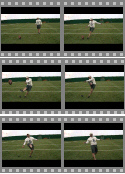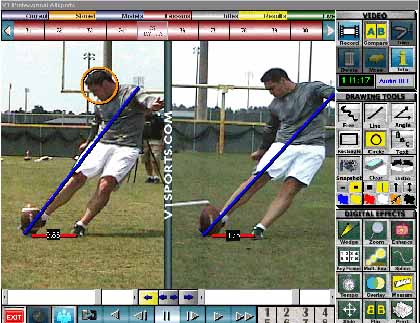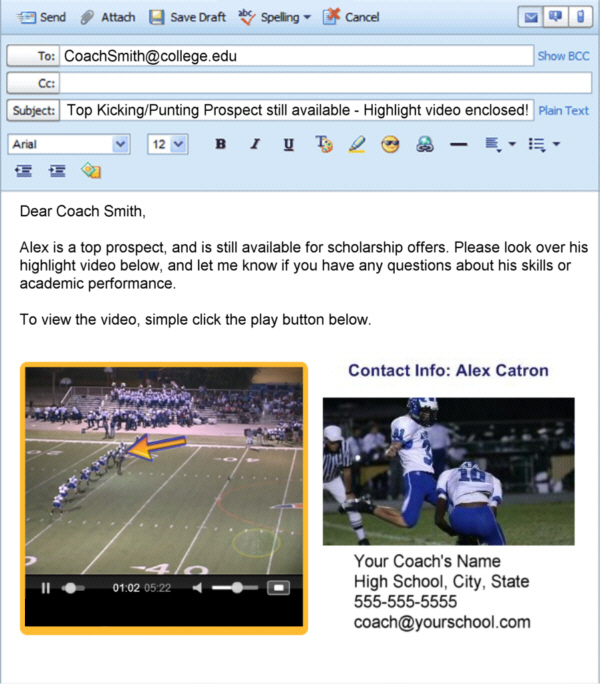|
GUEST EXPERT ARTICLE
As a professional kicking coach, regularly I am asked about how kickers can improve their flexibility and further extend their kicking distances. Over the years, I have noticed that kickers and punters lack functional strength. Punters in particular, who have a natural ability to kick the ball fifty yards consistently, often lack the proper extension and height on their follow through. In order to help with these issues, I start every kicking session with a dynamic warm-up and functional core strength routine to help loosen and warm-up the players. By combining functional training along with dynamic flexibility it helps add distance and consistency to kickoffs, field goals and punts in a matter of days.
Typically kickers and punters frequently make strength and speed gains in the weight room, but when they try to kick a punt or kick a field goal, there's no improvement. This is a common scenario because kickers and punters are given the same workouts as offensive lineman and wide receivers and don't train based on their specific position. For instance, when kickers kick they are ultimately balance on one foot. Kickers should always start on balance and finish on balance in order to have consistent kicks. After a summer of pure strength training, kickers and punters legs are stronger, but throughout the season their leg power diminishes and they tend to compensate by trying to kick harder which can lead to injuries. Neglecting the dynamic flexibility can easily send a kicker back to the weight room without him realizing that it could be something else in his work out routine that needs to be addressed.
This is why functional training and dynamic flexibility are an important part in training. What does functional training and dynamic flexibility mean? It means core, balance, rhythm, and dynamic movements in multiple planes. In any sport the core is the centerpiece of power. Whether performing squats in the weight room or tackling the running back, athletes rely on their core to help them perform their required action. Kickers use abdominals, hip flexors and their hips to perform a successful kick. By adding in some functional core strength, a kicker can add power to their kicks.
To give an example of a functional based balance exercise: Stand on one leg -- close your eyes and touch the ground with both hands lightly. Stand back up to a standing position, but continue to keep one foot off the ground. Repeat. Do 10-15 reps per side. You'll find out its not that easy. In this exercise you use the core of the body and the balance works the smaller intrinsic muscles of your ankle and foot. These elements are neglected in a regular strength program. As kickers know, locking your ankle on impact is an essential part of a successful kick; therefore you need to have strong ankles.
Another element that you can include is adding functionality in your warm-up. Try warming up with dynamic movement. The dynamic warm-up promotes hip, lower back, and hamstring flexibility, which are key elements of a healthy and consistent kicker. In a normal warm up kickers run around the field a couple times, perform a few leg swings, conduct a few static stretches and start kicking. They repeatedly forget about their lower back, groin and hip flexor areas. Getting high extension on punts and a good follow through help kickers get more distance on their kicks. As kickers enter higher levels of competition they will want to prepare the body properly to kick and achieve their highest level of performance.
To give you another example of a basic exercise is the Frankenstein walk. Put both hands out in front of you and kick your right leg to your left hand. Then do the opposite, kick your left leg to your right hand. Try to keep your leg as straight as possible. Try this slowly to start and as you get warmer, reach higher and higher.
Here is a few simpler dynamic warm- up exercises:
The kickers that I am coaching right now are on a functional training program. They have all given me the same feedback -- They feel more flexible and can kick further.
Before you continue to try these exercises. Continue to keep with your current strength and conditioning program (squats, bench, lunges, etc). But don't over train, you need to take out a running session or another workout from your current program to include this types of workouts. Your body will continue to develop outside the weight room. Working out every day and not giving yourself ample rest can also hinder any results that have been achieve in the weight room. Learn more about John Matich >>> |

 Functional Training For Kickers & Punters
Functional Training For Kickers & Punters


 Doug and Tommy's Frequently Asked Questions
Doug and Tommy's Frequently Asked Questions




